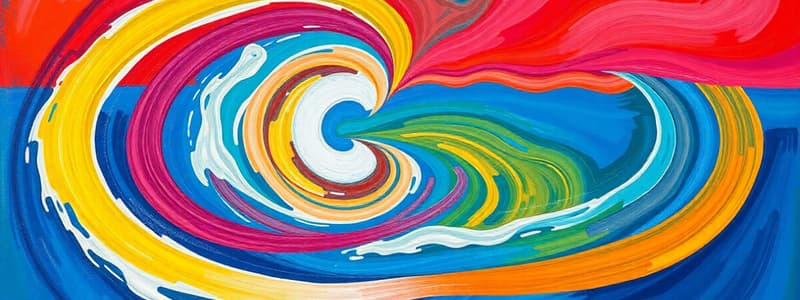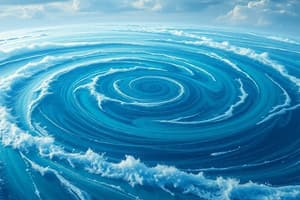Podcast
Questions and Answers
How does the Coriolis effect influence ocean currents in the Northern Hemisphere?
How does the Coriolis effect influence ocean currents in the Northern Hemisphere?
- It causes water to move directly towards the poles.
- It deflects water movement to the left.
- It has no effect on water movement.
- It deflects water movement to the right. (correct)
Ekman Transport describes the average movement of water at a 45-degree angle relative to the wind direction.
Ekman Transport describes the average movement of water at a 45-degree angle relative to the wind direction.
False (B)
What primarily drives surface ocean currents?
What primarily drives surface ocean currents?
Wind
A circular ocean current formed by Earth's wind patterns and the forces created by the planet's rotation is known as a ______.
A circular ocean current formed by Earth's wind patterns and the forces created by the planet's rotation is known as a ______.
What is the primary characteristic of water movement during upwelling?
What is the primary characteristic of water movement during upwelling?
Thermohaline circulation is driven by prevailing wind patterns across the ocean surface.
Thermohaline circulation is driven by prevailing wind patterns across the ocean surface.
Which of the following best describes a convection cell in the context of oceanography?
Which of the following best describes a convection cell in the context of oceanography?
Match the following adaptations to their corresponding abiotic stressors in the pelagic zone:
Match the following adaptations to their corresponding abiotic stressors in the pelagic zone:
Flashcards
Coriolis Effect
Coriolis Effect
Force from Earth's rotation, deflecting water right in the Northern Hemisphere and left in the Southern Hemisphere.
Current
Current
A continuous flow of charged particles moving in a circular path.
Ekman Transport
Ekman Transport
The average movement of water is 90 degrees, creating a swirling motion responsible for upwelling and downwelling.
Upwelling
Upwelling
Signup and view all the flashcards
Downwelling
Downwelling
Signup and view all the flashcards
Convection Cell
Convection Cell
Signup and view all the flashcards
Gyre
Gyre
Signup and view all the flashcards
Thermohaline Circulation
Thermohaline Circulation
Signup and view all the flashcards
Study Notes
- Oceanography is covered in these notes
Coriolis Effect
- A force is caused by Earth's rotation, deflecting water movement.
- Deflects to the right in the Northern Hemisphere.
- Deflects to the left in the Southern Hemisphere.
- Different latitudes travel at different speeds, creating the effect.
- A change in speed with latitude causes the Coriolis effect.
Currents
- Currents are the flow of charged particles moving in a circular motion and differ from waves.
- Surface currents move at an angle due to the Coriolis effect.
- The current flows at a 45-degree angle relative to wind directions.
- Wind drives currents; wind blowing across the ocean surface pushes the water.
Ekman Transport
- Average water movement is a 90-degree moving swirl.
- Generates vertical water motions, consisting of upwelling and downwelling.
Upwelling
- Upwelling is when water from the North goes to the shore.
- It involves the movement of deep water to the surface.
- The water is rather cold
Downwelling
- This is when wind from the South goes offshore due to the Coriolis effect.
- It involves the movement of surface water down.
- The water is rather warm.
Convection Cell
- Convection cell circulates fluid movement where warmer fluid rises
- Cooler fluid has a higher density and sinks
- Creates a cycle of rising and falling currents within a fluid like air or water.
Gyre
- This a circular ocean current
- Gyres are formed by Earth's wind patterns and the forces created by the rotation of the planet.
El Niño Southern Oscillation (ENSO)
- ENSO is a water surface current in the equatorial eastern Pacific
- This occurs periodically around Christmas
Thermocline
- Thermocline is the transition layer between warmer mixed water at the ocean's surface and cooler deep water below.
Thermohaline Circulation
- This is the movement of ocean currents that is driven by differences in water density.
Abiotic Stressors & Biotic Responses
- Open ocean conditions like (pelagic zone) temperature, light, and oxygen levels can be tough for marine life.
- Species adapted in various habits survive.
- Some fish have dark backs and light bellies to blend in.
- Deep-sea creatures create light in dark to find food or communicate.
- Tiny plankton move up and down in the water to stay safe and find food.
- Open ocean Stressors consist of the following: salinity, sunlight, and temperature.
- Camouflage is an adaptation to deal with open ocean stressors.
Plastics in the Open Ocean
- Microfibers harm by both polluting and being consumed by marine animals.
- Small creatures mistake microfibers for food making them sick, which spreads the plastic up the food chain.
- Over time, this hurts ocean ecosystems which affects seafood.
- Microbeads are tiny plastic particles that pollute oceans because they don't break down easily.
- Small sea animals swallow them by mistake, which spreads plastic through the food chain.
- Microbeads pollute and harm marine life, affecting seafood.
- Photodegradation degrades the plastic due to sunlight, which breaks it into tiny pieces.
- These bits spread in the water and are consumed by fish and other sea animals by mistake which harms marine life.
Studying That Suits You
Use AI to generate personalized quizzes and flashcards to suit your learning preferences.
Related Documents
Description
Notes on oceanography covering the Coriolis Effect, currents, Ekman Transport, and upwelling. The Coriolis Effect is a force caused by Earth's rotation, deflecting water movement. Currents are the flow of charged particles moving in a circular motion. Upwelling involves the movement of deep water to the surface.




